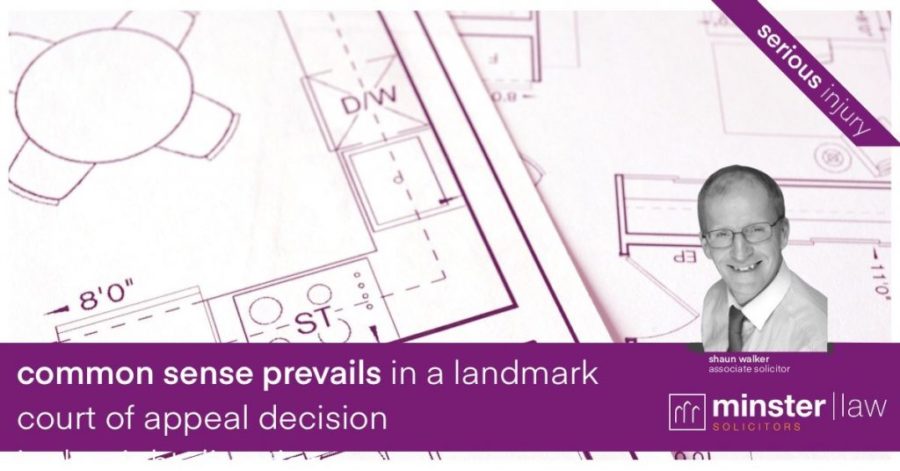
Associate solicitor Shaun Walker provides his opinion on the Swift v Carpenter judgment and the benefit it will have for many seriously injured claimants who require accommodation designed for their specific needs.
The old method of calculation for accommodation never worked as it was intended to do, and a complete overhaul of the approach to dealing with these claims was needed.
Historically, all attempts to deal with the old calculation method were thwarted by insurers who successfully bought off any potential appeals so as to maintain the status quo and to therefore maintain an air of uncertainty surrounding accommodation claims.
Insurers have deep pockets enabling them to choose which claims proceed to appeal, and so will it always be the case.
However, even the most hard-nosed insurer with an eye only for the reserve on the spreadsheet, will concede there was something very wrong with a system where the catastrophically injured claimant was prevented from pursuing a suitable accommodation claim.
This realisation dawned following the movement to a negative discount rate for all future losses.
The old calculation left the claimant with inadequate compensation to satisfy their accommodation requirements and therefore they had to use up other areas of damages secured in the claim e.g. damages for the actual injuries sustained, loss of earnings, care etc. just to put a suitable roof over their head.
Often those damages were tied up in annual payments requiring the claimant to take on a mortgage liability to secure the property they need.
A negative discount rate absurdly left the claimant with a nil valuation for accommodation claim.
Something had to be done.
The change in the discount rate for future loss calculations finally brought the issue to a head which culminated in the recent Swift decision.
The insurance industry will not be happy with the decision, but I doubt we will hear unsavoury language from them suggesting a “windfall” for claimants.
We are after all dealing with the most seriously injured where accommodation claims rightly have to be considered as fair and reasonable losses.
The sensible insurer will have recognised change was inevitable.
The insurers in the Swift case might appeal the decision but the grounds for doing so will be thin indeed.
I anticipate the prudent insurer will already have made adequate provision in their reserves in anticipating the decision in this case.
This outcome will not have come as a shock to the industry.
So, what is the new framework for dealing with accommodation claims? I have argued for some time that the only solution had to be the ability of a seriously injured claimant to be able to claim the difference in the cost of a house that would have been purchased but for the accident, and the cost of the house that is now required, suitably adapted for the claimant’s needs.
In an extreme example, that might mean the difference in the price tag between a terrace house and a bungalow.
That position has now been adopted in this recent decision with a clever calculation that will rightly benefit insurers to allow for the increase in value of the property over time.
Finally, the seriously injured claimant will receive damages for accommodation they are justly entitled to receive.
In the case of Mrs Swift, the difference in value between her “but for the accident” property and what she needed for the future, was £900,000.
There will therefore be significant increases in the value of high value claims where accommodation needs have to be addressed.
The question as to why the seriously injured claimant needs damages for accommodation might seem an obvious one.
It is easy to see the spinal cord injured claimant who is wheelchair dependant, needs single level accommodation suitably adapted for his needs – wide access doors, lower level kitchen work surfaces, room for therapies, wet room, a bedroom for the carer etc.
However, the position is not so clear with a spinal cord injured claimant who is seriously disabled but still has some function and is not wheelchair dependant.
This is where disputes can arise between the parties where the claimant puts forward a case that a new fully adapted single level property will be required in the future having regard to the claimant’s ageing profile (arguing he will be wheelchair dependant in later life), whereas the Defendant puts forward a contrary review that having regard to the claimant’s injuries, it is sufficient simply to adapt his current home.
These issues are difficult to resolve, and the dispute is often glossed over in negotiations.
At least now, claimants have more “power to their elbow” in those discussions given the calculation is simpler and will therefore assist negotiations.
Accommodation claims are also relevant in lower limb amputation claims.
It is true to say that the technology in prosthetics has improved dramatically in recent years and will continue to improve, but again, the ageing profile of the claimant cannot be ignored.
He or she might be more dependent on wheelchair use as they get older.
Simply making provision for the future installation of a stair lift for that individual is just not good enough.
A proper assessment has to be made of what the accommodation needs for that individual will be in the future including therefore the need for single level accommodation.
The condition and quality of the amputee’s retaining stump is often a significant factor in assessing what the future wheelchair dependency will look like.
It is not just the seriously physically disabled claimant who requires suitable accommodation.
The walking wounded who have sustained a serious brain injury might also be eligible for suitable single level accommodation in cases where balance is affected to such an extent that negotiating stairs is a very dangerous activity for that individual.
Accommodation claims are expensive claims to pursue and other factors come into play such as the negative impact on property value to a home that has been substantially adapted to meet the needs of a seriously injured claimant.
On eventual sale, the new owner faces a substantial bill in restoring the property to its original condition.
The involvement of an accommodation expert is essential to assist in the support of accommodation claims and to enable all variables to be considered.
In summary, the system is now fairer.
The old calculation never provided reasonable compensation for the seriously injured claimant in the context of modern property prices and a negative discount rate for future losses.
Many claimants will now be able to look to receive a significant percentage of the capital cost of their new accommodation.
Nonetheless, this development should not be looked upon as a victory for claimants but rather a victory for common sense.
This decision leaves the door slightly open for consideration of accommodation claims to be dealt with differently for those claimants who sadly have only a short life expectancy.
For those vulnerable clients, we will be actively exploring other routes to ensure that a fair compensation award is secure for those claimants.
For an in-depth analysis by Associate Solicitor Jonathan Bamforth click here.
For more information on Minster Law’s strategy for Swift v Carpenter on claims click here.



